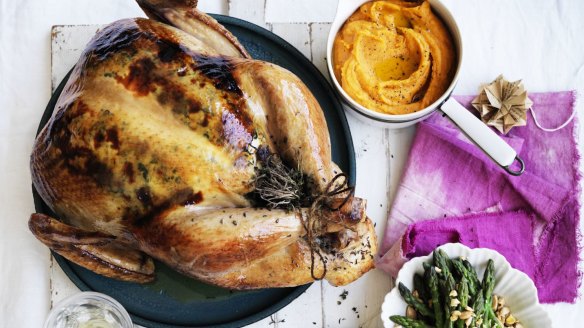How to make the perfect Christmas turkey

- How to brine a turkey
- Good Food Christmas recipe collection
- Neil Perry's turkey stuffed with ricotta
- How to make gravy
- How to glaze a ham
Not sure how to tackle a turkey this Christmas? We asked four experts for their tips for preparing and roasting the perfect bird.
Buying the right bird
Chef turned farmer Jerome Hoban of Gamekeepers in Victoria sources his turkeys from Victorian suppliers who raise, slaughter and freeze the birds throughout the year.
The annual peak in consumption means turkey farmers need to have large stocks of birds available and it's the reason why most people will roast a defrosted turkey this Christmas.
"Turkey farmers make 98 per cent of their income at Christmas so they have to process birds all year to meet demand," Hoban says.
Fresh, organic and free-range turkeys are in limited supply and usually must be ordered in advance. If you can't source a fresh turkey, keep in mind defrosting a whole frozen turkey will take several days. Always defrost it in the refrigerator in a roasting tray to catch the drips.
Hoban says you should apply the same principles you would use for buying any other poultry when buying turkey. "Use a good supplier and choose a nice-looking bird with a plump breast," he says.
Get ready to cook
In the US, where many people eat turkey year-round, you can find recipes for roasted, deep-fried and even barbecued turkey, but whatever your method of cooking, brining the bird first is one of the most popular ways to prepare the meat.
A co-owner of Collingwood's Rockwell and Sons, Casey Wall, was born in North Carolina and grew up eating turkey at Christmas and Thanksgiving.
Wall swears by the technique and brines all the restaurant's poultry before cooking. "It does two important things - it seasons and adds moisture to the meat," he says.
In its basic form, a brine is a solution of salt and water, but Wall says you can also add other flavours. "We add citrus peel, parsley, black pepper and coriander, but you can add any flavours you want," he says.
Basic salt and water brine uses a ratio of four tablespoons of salt to every four cups of water. The salt and water (and any other flavourings you want to add) need to be brought to a simmer and heated until the salt dissolves. The brine must then be cooled before using.
Once you've made and cooled your brine, submerge the turkey in the liquid, then cover and refrigerate, turning the turkey once.
After 12 hours remove the turkey and pat dry inside and out. Let the turkey stand for an hour in the fridge before roasting.
At Rockwell and Sons the juicy southern deep-fried chicken is always brined first and Wall says it's an easy technique that makes all the difference to the final dish.
Roasting
Canadian-born Serge Dansereau grew up eating turkey at Christmas. Now, as the chef and owner of the Bathers' Pavilion at Sydney's Balmoral beach, he serves it every year on Christmas Day to the restaurant's guests.
Dansereau says the main challenge when roasting turkey is keeping the meat moist through the long cooking time (at about 45 minutes per kilogram a turkey can take between two and three hours to cook).
To make sure the breast meat doesn't dry out, Dansereau removes the bird from the oven two-thirds into the cooking time and separates the legs from the breast. The legs go back into the oven for final cooking while the breast meat rests. When the legs are ready, he returns the breast to the oven for 15 minutes to warm.
Dansereau also recommends basting the bird with melted butter and towards the end of the roasting time adding sage leaves to flavour the meat (if add them too early they'll burn).
The breast meat can also be wrapped in foil with fresh sage while it's resting.
Leftovers
Mike McEnearney, the man behind Rosebery's Kitchen By Mike, has loads of ideas for using leftover turkey. His favourite dish is bubble and squeak, a mash of turkey leg meat, leftover roasted vegetables, brussels sprouts and stuffing fried until it forms a crisp cake, then served with a fried egg and some spinach.
McEnearney says you shouldn't overwhelm turkey's delicate gaminess with intense flavours. "Slice the breast meat and serve it with a salad of soft greens with a fruity marmalade dressing. Or team it with avocado, mango and radish."
He also suggests removing any breast meat from the carcass and making a stock with the bones much as you would with a roast chicken. Add chopped leftover breast meat to the finished soup.
McEnearney keeps to tradition and will be sharing a bird with his family at home on Christmas Day. "Many people don't like turkey. It can be dry, stringy and flavourless, but if you cook it properly, it's really juicy and full of flavour."
The best recipes from Australia's leading chefs straight to your inbox.
Sign up